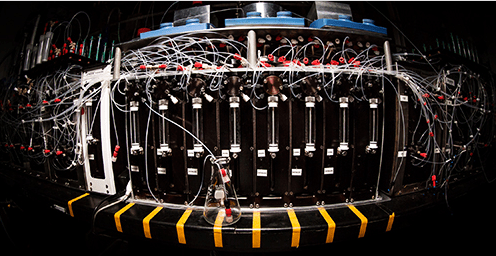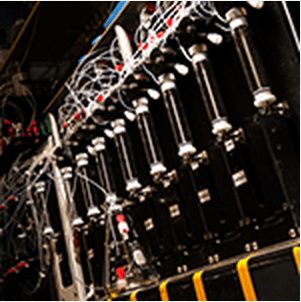University of Illinois Researchers Develop 3-D Printing Machine For Synthesizing Small Molecules
Researchers from the University of Illinois have built a novel molecule-making machine that acts like a 3-D printer at the molecular level. This complex looking machine has simplified the assembly procedure of smaller chemical building blocks that are used to form new small molecules. The team of chemists, headed by a chemistry professor and medical doctor Martin D. Burke, used a building block–based automated process that can at present methodically synthesize 14 different classes of small molecules. The newly formed closely-related chemicals can be used in the development of new medicines and technologies.

A simple catch-and-release chromatographic purification protocol that adds a single building block one by one is used for building small molecules from scratch efficiently. The automated building-block assembly method can also make molecules which consist of ring structures that are not easy to manufacture. The assembly is easy to carry out because the molecules are synthesized from the blocks that have the same chemical connector. Small molecules are the essential components of the technologies like solar cells and LEDs and are found throughout nature including cells and tissues. Burke also mentioned in a statement that this technology will broaden its scope and scalability in other therapeutic areas.

Thousands of building blocks are already commercially available and this automated synthesis technology can speed up the molecule building process as a trained chemist takes a very long time while trying to figure out how to make each one before the detailed study of complex, compact chemical structures is carried out. The technology has been licensed to REVOLUTION Medicines, Inc., which is co-founded by Burke.
To know more about the research you can have a detailed look at the #-Link-Snipped-# which was published online in the Journal Science, March 13, 2015 issue.
Source: #-Link-Snipped-# via #-Link-Snipped-#
A simple catch-and-release chromatographic purification protocol that adds a single building block one by one is used for building small molecules from scratch efficiently. The automated building-block assembly method can also make molecules which consist of ring structures that are not easy to manufacture. The assembly is easy to carry out because the molecules are synthesized from the blocks that have the same chemical connector. Small molecules are the essential components of the technologies like solar cells and LEDs and are found throughout nature including cells and tissues. Burke also mentioned in a statement that this technology will broaden its scope and scalability in other therapeutic areas.
Thousands of building blocks are already commercially available and this automated synthesis technology can speed up the molecule building process as a trained chemist takes a very long time while trying to figure out how to make each one before the detailed study of complex, compact chemical structures is carried out. The technology has been licensed to REVOLUTION Medicines, Inc., which is co-founded by Burke.
To know more about the research you can have a detailed look at the #-Link-Snipped-# which was published online in the Journal Science, March 13, 2015 issue.
Source: #-Link-Snipped-# via #-Link-Snipped-#
0
